Solemn parade to the day of the Navy. Naval parades of the Russian fleet
The Russian Defense Ministry is reviving the tradition of holding parades on Navy Day. As noted in the department, this is one of the most important military rituals, which in itself is a source of pride for one's country, a vivid and unforgettable spectacle.
Russian President Vladimir Putin, by his decree, ordered "to commemorate the glorious victories of the Navy, which made a significant contribution to the defense of the Fatherland" to hold the main naval parade in St. Petersburg. At a press conference on July 27 following the talks in Finland, Putin invited foreign partners from the Baltic region to take part in the parade. "I assure you, this is not saber rattling. This is the restoration of traditions that are over 100 years old," he said.
Main the parade will take place in the historical part of the city and at the historical base of the Baltic Fleet in Kronstadt. It will involve ships, ships, submarines and aircraft of the Baltic, Northern, Black Sea fleets and the Caspian flotilla.
It is expected that this event will even surpass the celebration of the 300th anniversary of the fleet in 1996 in scope. In terms of the scale of the event, the number of ships and aircraft involved, this event can be compared with the Victory Parade on May 9 on Red Square in Moscow.
Previously, Navy Day was celebrated only in the main fleet bases - Astrakhan, St. Petersburg, Severomorsk, Sevastopol and Vladivostok, but on a much more modest scale and did not have the status of an all-Russian event.
Peter's traditions
The parade will take place in the waters of the Neva in St. Petersburg and on the Kronstadt sea road. As Deputy Commander-in-Chief of the Russian Navy Alexander Fedotenkov explained, holding such celebrations is a return to the traditions of Peter the Great, who held a review of the ships after the decisive victory of the Russian fleet at Gangut in 1714.
"For the first time in the history of naval parades in St. Petersburg, more than five thousand sailors of the Baltic, Northern, Black Sea fleets and the Caspian flotilla will take part in the celebrations," the Defense Ministry said. The Navy emphasizes that the parade preparation period coincided with the stay in St. Petersburg of the relics of Nicholas the Wonderworker, who is considered the patron saint of sailors.
The parade is always a review of the achievements of the domestic military-industrial complex, the professionalism and skill of the military, their bearing and youthfulness, the level of combat readiness and, if all this is generalized, the degree of defense of the state Viktor Litovkin TASS military observer
The expert recalls that there are parades in all the leading countries of the world - in France, in the USA, China, Great Britain, even in Poland. “Of course, a parade is not a saber-rattling, it is a demonstration of the pride and glory of the Fatherland. And who understands this and how it depends on a person’s civic position, his spirituality,” says Litovkin.
Expand
Nuclear-powered missile cruiser "Peter the Great" in Kronstadt
© Oleg Kuleshov 
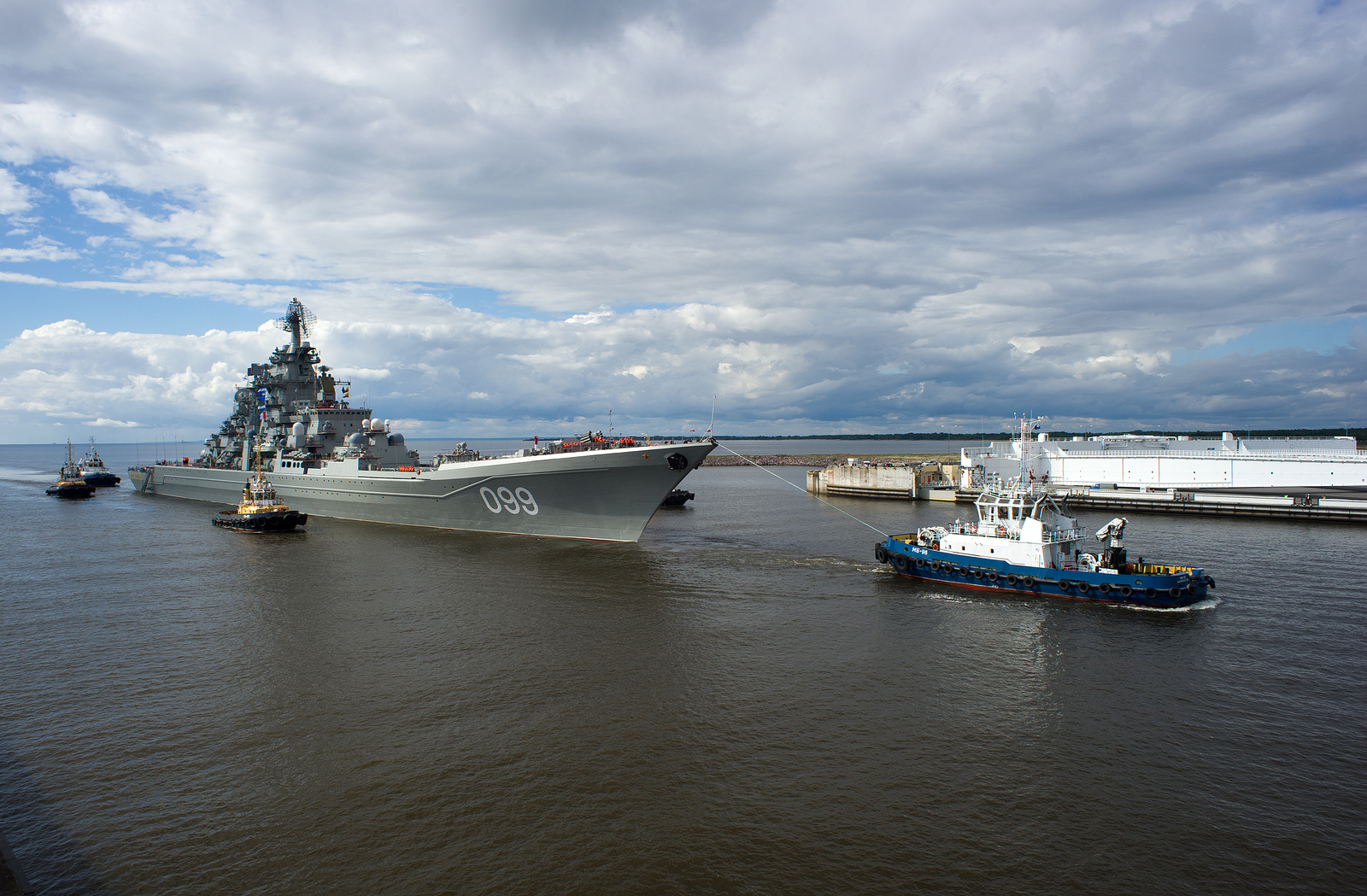
Nuclear-powered missile cruiser "Peter the Great" in Kronstadt
© Oleg Kuleshov
According to the ex-Deputy Commander of the Russian Navy, Admiral Igor Kasatonov, such large-scale naval parades were held only twice: in 1995 on the 50th anniversary of the Great Victory and in 1996 on the 300th anniversary of the Russian fleet. The current parade of such a level testifies to the high confidence in the fleet and those sailors who, as part of interspecific groups, solved tasks in the Mediterranean Sea and in all maritime theaters of operations.
There is an opportunity to popularize our Navy, and it's great that three fleets are gathering in one place in our sea capital - St. Petersburg Igor Kasatonov
The admiral recalls that a naval parade of a similar scale was held in 1957, commanded by Marshal Soviet Union Georgy Zhukov.
The whole embankment, having broken temporary partitions, went down to the Neva to examine the great commander, who was dressed in military uniform clothes No. 1, was in all white ... It was all very solemn Igor Kasatonov Advisor to the Chief of the General Staff of the RF Armed Forces, Admiral
In total, more than 60 warships and submarines will take part in the main parade of the 2017 model, more than 40 aircraft and helicopters of the Naval Aviation will fly in the sky over the city.
TASS/Ruptly
Spectators will be able to see the Peter the Great heavy nuclear missile cruiser, the world's largest nuclear submarine Dmitry Donskoy, a number of the latest Navy ships - the Ivan Gren landing ship, the Admiral Makarov frigate, the Veliky Novgorod and Vladikavkaz submarines. . By the way, for the first time in the history of St. daytime four bridges across the Neva will be raised simultaneously.
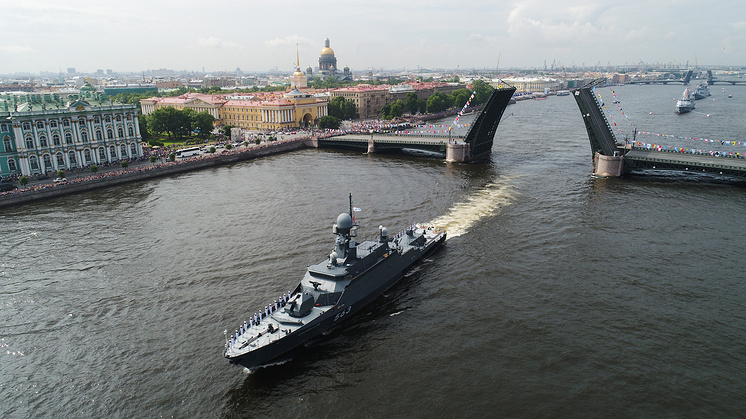
Expand
© Petr Kovalev/TASS

© Petr Kovalev/TASS
Ships from China will also take part in the holiday - the Hefei destroyer, the Yuncheng frigate and the Lomahu support vessel, which participated in the Sea Interaction 2017 joint exercises in the Baltic.
China claims to be a great maritime power, much, of course, is borrowed from us. But the Chinese comrades can be envied in a good way, because they have already built their own aircraft carrier, they have 26 ships of the 1st and 2nd rank every year, wonderful frigates ... They properly dispose of this high-tech intellectual baggage Igor Kasatonov Advisor to the Chief of the General Staff of the RF Armed Forces, Admiral
The solemn event will end with the passage of the parade group of naval aviation in the amount of 46 aircraft over the Senate Square. Among them are Su-33 and MiG-29K shipborne fighters, Su-24M coastal aviation bombers and the multifunctional Su-30SM replacing them, MiG-31BM interceptors, Il-38 and Tu-142M anti-submarine aircraft, and some others. Also in the air part of the parade will be presented the latest helicopters Ka-52K "Katran" (deck version of the attack "Alligators") and traditional naval Ka-27 and Ka-29, as well as combat transport Mi-8 and Mi-24VP.
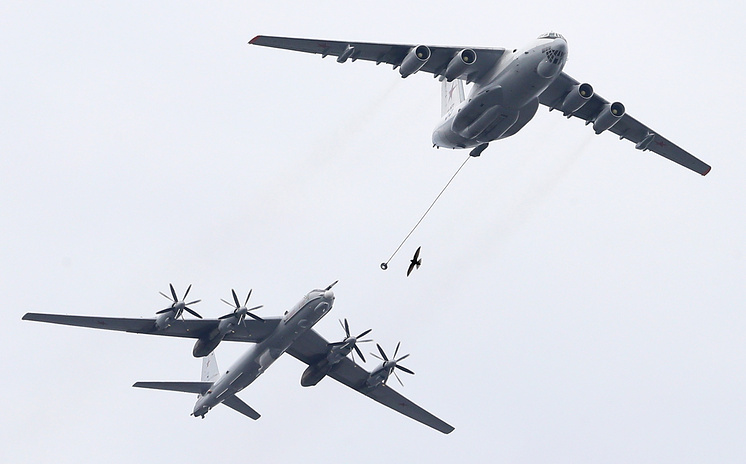
Expand
Air refueling demonstration by Il-78 tanker aircraft and Tu-142MR long-range maritime reconnaissance aircraft
© Alexander Demyanchuk/TASS 

Air refueling demonstration by Il-78 tanker aircraft and Tu-142MR long-range maritime reconnaissance aircraft
© Alexander Demyanchuk/TASS
After the parade, the festival of naval bands "Anchor Square" will take place in St. Petersburg, open days will be held in naval museums, libraries and educational institutions. Residents and guests of the city will be able to visit surface ships and submarines.
"Shark" in Kronstadt
On July 26, the heavy strategic missile submarine "Dmitry Donskoy" arrived in Kronstadt from the Barents Sea. The day before, the nuclear-powered missile cruiser Peter the Great arrived there. This inter-naval transition of Russian sea giants did not go unnoticed by the Western media. The Swedish edition of Expressen quotes security adviser Joachim von Braun, who considers the dispatch of Russian ships a "clear signal".
"The Russian Armed Forces send us a clear message: they want to emphasize that they are great and strong. Russia is a state that looks down on countries it considers weak, which is why it is so important for her that we notice her," the newspaper writes.

Expand
Strategic missile submarine "Dmitry Donskoy"
© Oleg Kuleshov 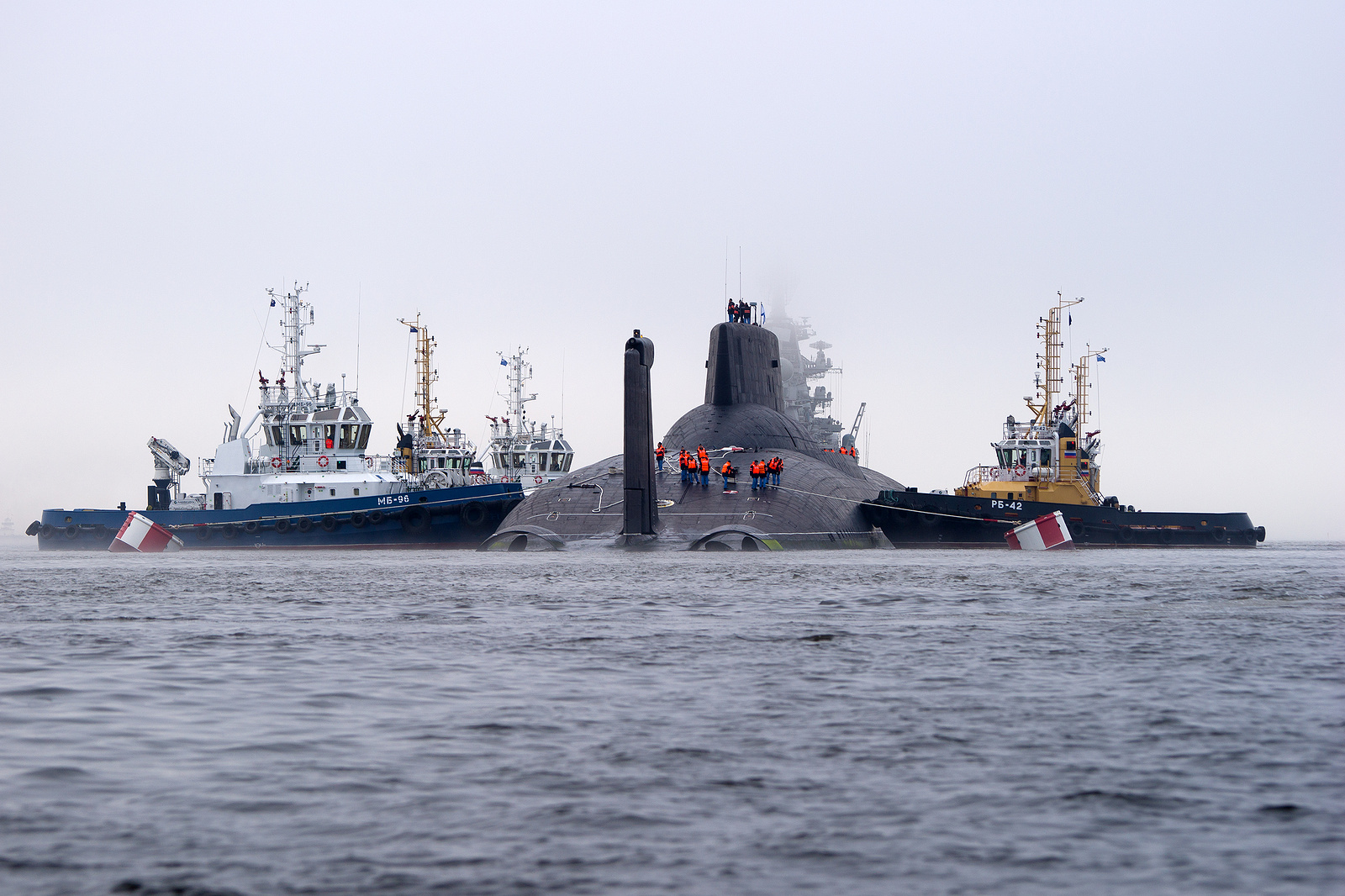
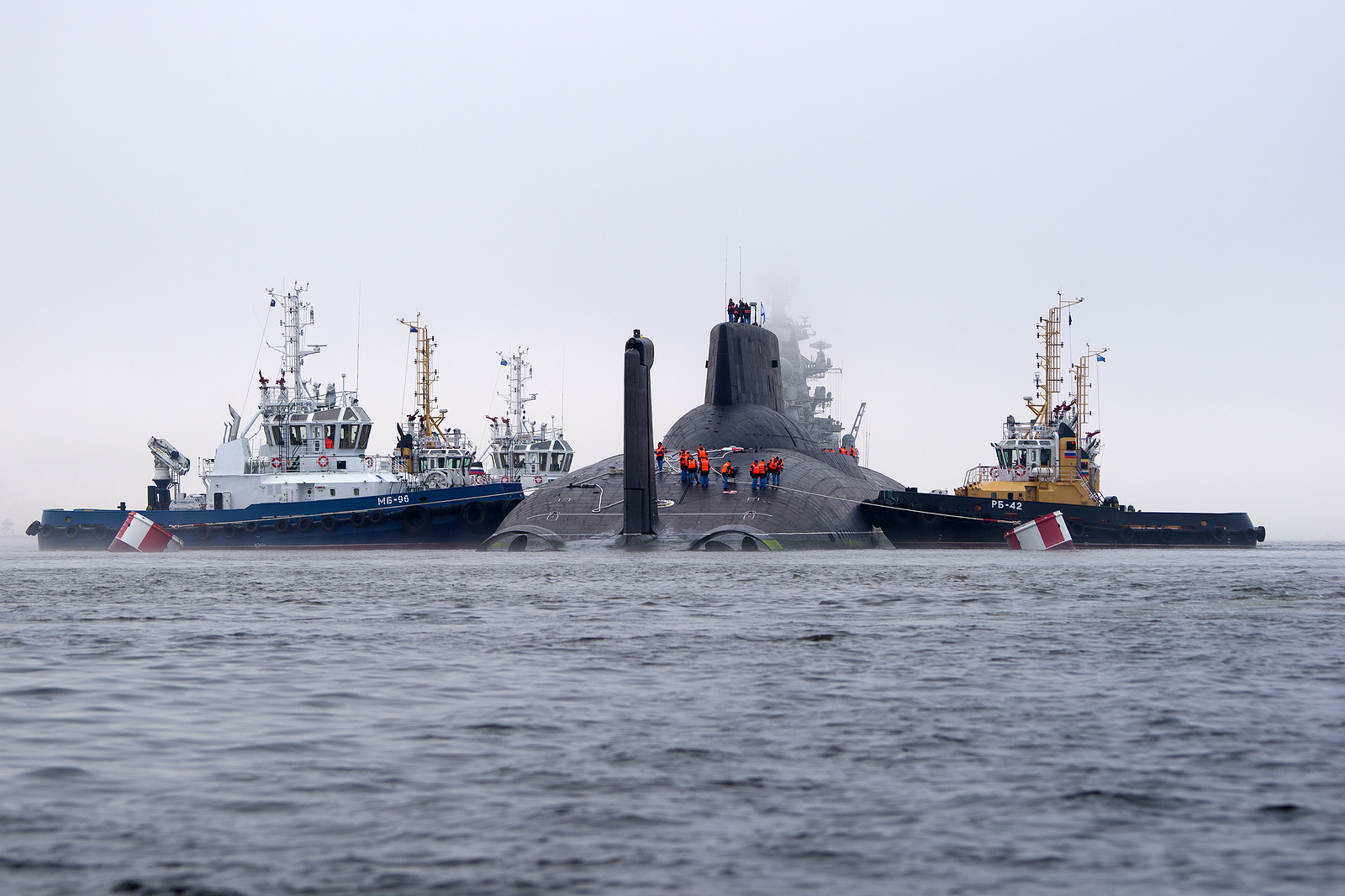
Strategic missile submarine "Dmitry Donskoy"
© Oleg Kuleshov
Such excitement in the Western media in relation to our parade, according to TASS military observer Viktor Litovkin, is caused by the Russophobic position of many political forces in the United States and Europe, "Russia was defeated in the Cold War and now must be lower than grass, quieter than water."
The revival of our country as a major political player on the world stage, strengthening the power of the army, sovereign and independent politics in the international arena ... Endless sanctions, nit-picking about and without. And, of course, the demonstration of our naval power in the center of Europe in the Baltic, which NATO has turned into an inland sea, the passage of the world's largest warships with a nuclear power plant is a blow to all the myths about "backward Russia" Viktor Litovkin TASS military observer
"Dmitry Donskoy" is the only nuclear submarine of project 941 remaining in the Russian Navy (code "Shark", "Typhoon" according to NATO classification - TASS note). These are the largest nuclear submarines in the world. In total, six of them were built in the Soviet Union. Their length - 175 m, width - almost 23 m, displacement - up to 49 thousand tons. It is believed that the "Sharks" were a response to the construction of American submarines of the "Ohio" type. The dimensions of Soviet boats are determined by the dimensions of the R-39 (RSM-52) intercontinental ballistic missiles, with each boat carrying 20 such missiles.
Geography of parades
The parades will be held in the cities - naval bases - Severomorsk, Baltiysk, Sevastopol and Vladivostok - base points, fleets, as well as the Caspian Flotilla. In total, about 200 warships, boats and support vessels will be involved. The teleconference will connect all the celebrations into a single broadcast.
AT Sevastopol, in addition to the parade as the main event, a military sports festival is planned, as well as an exhibition of weapons and military equipment, excursions to ships and a free visit to the fleet museum. The festive day will end with a gala concert on Nakhimov Square, fireworks and fireworks. Among the participants in the parade are the flagship of the Black Sea Fleet - the missile cruiser Moskva, the diesel submarine Stary Oskol, the latest frigate Admiral Grigorovich, the training ship of the Baltic Fleet Perekop and the oldest rescue ship in the fleet, Commune. the heavy aircraft-carrying cruiser "Admiral Kuznetsov", the strategic missile submarine "Verkhoturye" and the nuclear submarine missile cruiser "Orel". The nuclear submarine "Obninsk" and the diesel-electric submarine "Kaluga" will demonstrate immersion and ascent to the audience.
AT Baltiysk the parade formation will be led by the destroyer "Persistent". In total, more than 30 warships and about 1.5 thousand military personnel of the Baltic Fleet will take part. Residents and guests of the city will be able to visit the ships of the fleet - the small missile ship Zyb and the small anti-submarine ship Aleksin.
AT Astrakhan Crews of the Veliky Ustyug small rocket ship and the Volgodonsk small artillery ship will show combat exercises to repel air enemy attacks to residents and guests.
Syrian raid
For the first time in recent history The Russian Navy will hold a naval parade near the Syrian coast. At the logistics point in Tartus, the ships of the fleet carrying a combat watch in the Mediterranean Sea will pass in parade wake formation, as in St. Petersburg.
Let everyone see what the Russian fleet is today and try to understand that we are now forever in the Mediterranean. As the successors of the Soviet 5th Mediterranean Squadron (an operational formation of ships intended to solve combat missions during the Cold War - TASS note). With all the ensuing consequences for other players in the Mediterranean and the Middle East Viktor Litovkin TASS military observer
Now off the coast of Syria there is a new frigate of the Black Sea Fleet "Admiral Essen", a patrol boat "Inquisitive", a submarine "Krasnodar". the minesweeper "Valentin Pikul", a killer ship and anti-sabotage boats. In honor of the holiday, Russian planes will fly over Tartus from the Khmeimim airbase.
Roman Azanov
Annotation. The article reveals the history of naval parades of the Russian Navy as one of its glorious traditions, and the participation of ships of the Russian and Soviet Navy in naval parades of foreign states.
summary. The article reveals the history of naval parade of Russian Navy, as one of its glorious traditions, and the participation of ships of the Russian and Soviet Navy in the naval parades in foreign countries.
MILITARY CHRONICLE OF THE HOMELAND
Zaitsev Yuri Mikhailovich- Associate Professor of the Department of Tactics, Combat Training and Naval Practice of the Pacific Higher Naval School named after S.O. Makarova, Candidate of Historical Sciences
ShugaleyIgor Fedorovich- Lecturer at the Department of Tactics, Combat Training and Naval Practice of the Pacific Higher Naval School named after S.O. Makarova, captain 2nd rank reserve, associate professor
(Vladivostok. E-mail: [email protected]).
NAVAL PARADES OF THE RUSSIAN FLEET
Naval parades1 are one of the most important military rituals and one of the traditions of the Russian Navy. This is not only a demonstration of the power of the fleet and its merits in ensuring the defense of the Motherland, its inviolability and security, but also a certain review of the combat readiness of ships and personnel. Naval parades are inextricably linked with the name of Peter I, with the creation of a regular fleet and his first naval victories. It is believed that the solemn meeting of the Russian squadron after its brilliant victory over the Swedish fleet in July 1714 during the Northern War was the first naval parade. Peter I, evaluating its importance, equated it with the victory at Poltava in 1709. This was the first major naval victory of the young Russian fleet, which forced other maritime powers in the Baltic to reckon with its strength. Literally the next day after the defeat of the Swedish fleet and the capture of its ships and the commander of the fleet, Rear Admiral Ehrenskiold, Peter I sent couriers from Reval to St. Petersburg, Moscow and other cities with news of the events at Gangut.
In St. Petersburg, this news was received at the beginning of August 1714 and they began to prepare for the solemn ceremony. On Trinity Square, triumphal gates were hastily erected, which were crowned by an eagle sitting on the back of an elephant with a paraphrased winged Latin saying “ Aquila non capital muscas» - “The Russian eagle does not catch flies” with a hint of the captured flagship of the Swedish fleet “Elephant”2. Near the Summer Garden, the Menshikov and Kikin chambers, Winter Palace, on the piers and near the walls Peter and Paul Fortress pyramids were erected for fireworks and illumination.
In the early morning of September 18 (9), a squadron of victorious ships began to be drawn into the mouth of the Neva. By noon, the embankments of the capital were flooded with people waiting for the solemn welcome of the ships. The slender wake column was headed by the flagship battleship Ingermanland with the state standard raised. It was followed by galleys and scampaways of the Russian squadron, decorated with flags, and the captive frigate "Elephant" with the commander of the Swedish fleet Ehrenskiold and other Swedish ships closed the line. The winners were greeted by a volley of fortress guns. The ships anchored in front of the Trinity Pier, and the ship's guns announced their victory. And the artillery of the fortress and the Admiralty responded with a triple volley. The jubilant voices of the greeters were drowned in the sounds of trumpets, timpani and drums. The boats rolled off the ships, and all the teams went ashore to participate in the ground parade. The first company to pass through the triumphal gates was a company of the Life Guards Preobrazhensky Regiment under the command of Major General I.M. Golovin, who commanded a detachment of 9 scampaways in the Gangut battle. Two companies of the Astrakhan regiment followed the Preobrazhenians, carrying captured banners and standards, followed by captured naval officers led by Ehrenskiold, naval non-commissioned officers, soldiers and sailors. The parade was closed by two companies of Preobrazhenians, led by Peter I, and five non-commissioned officers carrying the captured flag of the Swedish Rear Admiral.
With the onset of darkness, the city was decorated with allegorical fireworks - "the victorious fleet." Opposite the Summer Garden, a ship was placed with illuminated banners, where the inscription flashed with bright lights: “Although they hit me from all sides, I rise.” Various figures were burning on the sides. All houses on the occasion of the holiday were lit with candles, and lanterns burned in front of the palaces and on the main streets. An extensive shopping area, where illuminated banners stood, and the nearest streets were filled with people3.
From this first parade, St. Petersburg became the capital of all naval parades. During the reign of Peter I, the practice of naval parades is already becoming a tradition, acquiring new details and features. On the second anniversary of the Peace of Nishtad in 1723, by decision of the tsar, the "grandfather of the Russian fleet" was brought to St. Petersburg, as Peter I called his boat, on which he mastered the basics of ship control. A special ceremony was arranged for his meeting - the Nevsky Fleet (private ships located in St. Petersburg) was put up at the walls of the Alexander Nevsky Monastery. On May 31, the boat, accompanied by the Nevsky Fleet, moved to the Peter and Paul Fortress, which saluted him with 31 volleys. The very first meeting of the boat with warships took place on the eve of the celebration of the second anniversary of the Peace of Nystad on August 11, 1723. To commemorate this historical event 21 battleships of the Baltic Fleet were lined up in a wake column on the Kronstadt roadstead. All ships were painted with signal flags. Towed by boats from the flagship, the little boat passed along the line of ships, which saluted him with more than a thousand guns. The crew of the boat was interesting - Peter I himself was at the wheel, and behind the oars were his associates in the organization and construction of the fleet, Vice Admiral P.I. Sivere, T. Gordon, Rear Admirals N.A. Senyavin and T. Sanders, A.D. Menshikov, gunner - chief gunner O. Khristian. The position of commander was none other than a participant in all the campaigns of Peter and the Gangut battle of F.M. Apraksin.
In 1849, Nicholas I arranged a review of the Black Sea squadron, in which almost all the ships of the fleet participated. Accompanying the emperor, the artist I.K. Aivazovsky, decades later, in 1886, will paint the well-known painting "Review of the Black Sea Fleet in 1849", which is now in the Central Naval Museum of St. Petersburg. The review was held at the Sevastopol roadstead. The parade was hosted by Nicholas I, who was on board the steam frigate "Vladimir". At the head of the formation of ships is the battleship "The Twelve Apostles", followed by "Rostislav", "Svyatoslav" and "Yagudiel". Four years later, the ships participating in the parade will write their names in the history of the victories of the Russian fleet in the Battle of Sinop.
The military parade of ships was hosted by the tsar, members of the royal family, commanders of fleets and squadrons. Those who received the parade on boats, first on oar boats, then on steam or motor boats, went around all the ships in turn, the buglers played “Entrance”, the orchestras performed admiral marches. After congratulations on the holiday, the crews of the ships answered "Hurrah!". With the arrival of the hosts of the parade on the flagship, the national anthem was played and a festive artillery salute was fired. These gunshot smokes and, strange to say, their sounds, produced the main beauty of the spectacle. On sailing ships, on especially solemn occasions, the team was sent across the mars and yards."four.
It was precisely such naval parades that were perceived as theatrical spectacles that were parades in honor of the 200th anniversary of the birth of Peter the Great in June 1872 and the 100th anniversary of the Battle of Borodino in 1912 with the participation of the Atlantic squadron.
Subsequently, naval parades on Navy Day became traditional, interrupted only during the Great Patriotic War. However, with its end, this spectacular demonstration of the strength and power of the domestic fleet was resumed. Until 1981, the holiday and, accordingly, naval parades were held on July 24, and on October 1, 1980, by Decree of the Presidium of the Supreme Soviet of the USSR No. 3018-X “On Holidays and Commemorative Dates”, Navy Day was postponed to the last Sunday of July. Then this date was confirmed by the Decree of the Presidium of the Supreme Soviet of the USSR dated November 1, 1988 No. 9724-XI "On Amendments to the USSR Legislation on Holidays and Commemorative Dates." And, finally, by Decree of the President of Russia dated May 31, 2006 No. 549 “On the establishment of professional holidays and memorable days in the Armed Forces Russian Federation» The Day of the Navy of the Russian Federation is set as a memorable day. As before, it is celebrated annually on the last Sunday of July.
In the Ship Charter of the USSR Navy, and now in the Ship Charter of the Russian Navy, a separate section sets out the procedure and ritual for holding naval parades5. The charter defines a list of events on which naval parades can be held: by special order, in commemoration of public holidays and important events state and military importance.
Naval parades demonstrate the power of the fleet for politicians and spectators, but they have one more feature: here sailors have a rare opportunity to show the naval training of ship crews, as they say, “according to the Hamburg score”6. And this is especially important when Russian ships participate in naval parades of foreign countries, because the Navy, like no other type armed forces, in addition to direct tasks, it also performs the most important state mission - demonstrating the flag in various parts of the oceans. This diplomatic mission sometimes gives more than long negotiations - the crews of the ships carry our culture, acquaint the receiving party with our customs and mores. Of course, this imposes a special responsibility on all crew members.
In 1937, the battleship "Marat", which participated in the international naval parade on the Spithead raid in connection with the coronation of George VI, proved to be excellent. The ship under the command of the flagship of the 2nd rank V.I. Ivanova for 11 years was the best ship in the Baltic Fleet. It continued to serve those who began their service in the First World War. The senior assistant on the ship was the future commander of the Red Banner Baltic Fleet during the war, V.F. Tributs, transferred to this position from the headquarters of the fleet for the duration of a responsible campaign. To strengthen the navigator's service, teachers from the school named after V.I. M.V. Frunze and supernumerary commanders of BCH-1. Two chefs from the Astoria restaurant were taken on board to serve the wardroom.
It should be noted that the neighbor of the "Marat" from the starboard side of the battleship "Deutschland" spent more than two hours on a similar setting (despite the fact that the design of its hawse was more convenient, and the weight of the chain links was less than that of the "Marat"). The Argentine battleship "Moreno", having suffered with the setting for half a day, remained at one anchor7. In the morning, all the newspapers in Portsmouth came out with big headlines about the successful work of the Soviet sailors. Unfortunately, the domestic maritime press at that time limited the coverage of the participation of our ship in the parade to publishing in the journal "Sea Collection" only a picture of individual ships participating in the parade8. Coincidentally or not, it was after the participation of the Marat in the naval parade on July 17, 1937 that a bilateral Anglo-Soviet naval agreement was signed in London.
The next participation of the Soviet ship in the naval parade on the Spithead raid took place only in 1953. On June 2, 1953, the coronation ceremony of Queen Elizabeth II took place in London. This event has become one of the most spectacular in the history of Britain in the 20th century and a real holiday for the whole country, the first grandiose event after the difficult post-war years.
To participate in the naval parade, the lead newest cruiser of project 68bis "Sverdlov" was allocated. This was the first foreign trip of our ships after World War II. The importance attached to it is evidenced by the fact that the day before the departure, the Minister of the Navy of the USSR, Admiral N.G., arrived on the cruiser. Kuznetsov. Addressing the crew of the cruiser, he said: “You have been entrusted with the responsible task of the government, and by doing it, you will either help the government to make policy, or hinder it. I express confidence in the success of your campaign!
In the post-Soviet period, ships of the Russian Navy have repeatedly taken part in various international events, including naval parades. The parade at the Pearl Harbor naval base during the celebration of the 50th anniversary of the end of World War II was grandiose in its scale and number of participants. A detachment of ships of the Pacific Fleet took part in this parade, consisting of the large anti-submarine ship "Admiral Vinogradov" and the large landing ship "Nikolai Vilkov" under the flag of the chief of staff of the fleet, Vice Admiral O.M. Faleev. Ships from the United States, Australia, New Zealand, Singapore, Indonesia and others took part in the celebration. better side. The parade of ships took place on September 2, the day Japan signed the act of surrender. A particularly striking element was the passage of ships in joint formation. Aircraft from the air wing of the aircraft carrier Carl Vinson, as well as naval aviation aircraft from the Second World War, flew over the formation of ships.
The new millennium was marked by the participation of Pacific Fleet ships in naval parades dedicated to the anniversaries of the region's navies. So in the naval parade in Mumbai (India), which was given the name "Bridges of Friendship" (Bridges of Friendship), large anti-submarine ships "Admiral Panteleev", "Admiral Vinogradov" and the tanker "Vladimir Kolechitsky" took part. The detachment of ships was headed by Deputy Commander of the Pacific Fleet, Vice Admiral A.V. Konev. The celebration of the 50th anniversary of the creation of the Indian Navy was attended by 66 warships and vessels from 20 states, including not only the region, but also those that do not often represent their fleets in this theater: Morocco, Oman, Poland, Saudi Arabia, Kenya, Mauritania, etc. It is characteristic that the submarines of India and France also took part in this parade. The host parade went around all the ships lined up in connection with the peculiarities of the bay in seven lines. The special relationship between our two countries - strategic partners - also determined the attitude with which the host country met the envoys of the Russian Navy9.
In October 2002, a naval parade was held to commemorate the 50th anniversary of the establishment of the Japan Maritime Self-Defense Force. Under the flag of the Commander of the Primorsky Flotilla, Rear Admiral M.L. Abramov, the Varyag guards missile cruiser, the R-18 missile boat and the Project 877 B-345 submarine took part in it. In addition to the ships of the Russian Navy, the ships of the US Navy, the Republic of Korea, France, India, Australia, Singapore, New Zealand, Malaysia, Thailand, Chile and, of course, Japan took part in this parade. More than 40 ships were lined up in the line of wake columns. Our submarine was the only one among this type of ships. All festive events ended with international relief and rescue exercises10.
Naval parades recent years they no longer require such complex manipulations when placing wake columns in a line as before, however, both the hosts and all the guests observe the maneuvers of the ships with interest, and note both obvious successes and flaws of the parade participants. Nothing will pass by experienced eyes. It would be nice if the demonstration of the strength and power of ships was limited only to competitions in matters of maritime practice and ship management, participation in maritime parades and humanitarian exercises. But as long as some of our neighbors see Russia only as an enemy, our people must know with what forces and means the Navy is ready to defend our Fatherland from the sea. However, I want to emphasize: as long as there are fleets, there will be naval parades. And not as a deterrent, but as bridges between states and peoples. Therefore, the motto of the naval parade in Mumbai - "Bridges of Friendship" - was very symbolic.<…>
NOTES
1 Parade (from lat. paro- preparing) - a review of troops, forces, held to commemorate the holidays, on the occasion of various celebrations of state and military significance, and sometimes after the completion of military exercises (maneuvers). The procedure for their implementation is regulated by charters and orders. See Naval Encyclopedic Dictionary. M.: Military Publishing House, 2003. S. 587.
2 "Aquila non capit muscas" - i.e. great person does not engage in petty matters, he ignores everything petty and insignificant.
3 Glushankov I.V. Towards the unknown. L.: Gidrometeoizdat, 1980; Traditions of the Russian Navy. Vladivostok, TOVMI, 2005, pp. 175–177; Radolgin A.A., Fateev M.A. On the points of naval glory. L .: Shipbuilding, 1988. S. 70.
4 Kritsky N.N., Zaitsev Yu.M., Shugaley I.F. Traditions of the Russian Navy. Vladivostok, TOVMI, 2005. S. 177, 178.
5 Ship charter of the Navy. Moscow: Military Publishing House, 2002, pp. 311–314.
6 This expression arose at the beginning of the twentieth century, when in the city of Hamburg, behind closed doors, professional circus wrestlers held competitions to determine who is real, and not for the press and the public, who is stronger on the carpet.
7 Pravdyuk V.V. Sea routes: Libava - Kronstadt - Washington. 1933–1960 Vyborg: "Fantakt", 1994. S.27–29.
8 Marine collection. 1937. No. 10 (insert).
9 Bridges of Friendship. International Fleet Review 2001. Mumbai, Standard Press, IN, 2001.
0 International Fleet Review 2002. Tokyo, JMSDF, 2002.
Good morning! Very soon, a naval parade in honor of the Navy Day will begin in St. Petersburg. The weather is cloudy today, but the weatherman promised that there would be no rain. Tens of thousands of Petersburgers and guests of the city came to watch the parade. Spectators have already taken their places along the embankments. Citizens are photographed against the backdrop of raised bridges: they were specially raised so that heavy ships could pass unhindered along the Neva.
The boat of the President of Russia is approaching the University embankment. Naval aviation advanced to the main place of celebrations. The ships are already standing along the embankments of the Neva.
The parade begins with a shot from the Peter and Paul Fortress. A military band is playing a march.
"Congratulations on the Day of the Navy!" - Vladimir Putin addressed the sailors.
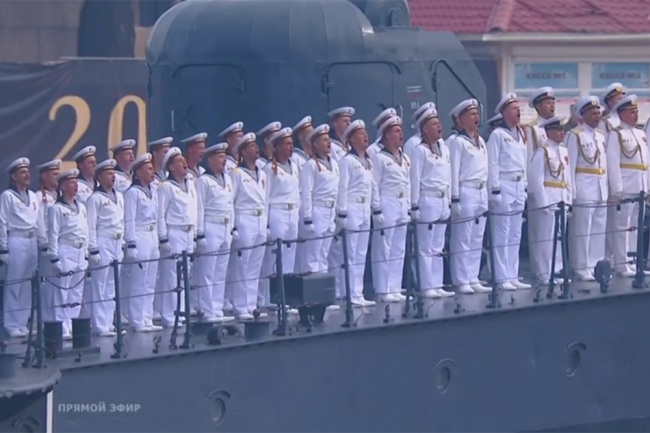
Boat number 001, where Vladimir Putin is located, passes by the large landing ship "Minsk". It has been part of the Baltic Fleet since 1983. Project 775 large landing ships are the main force for amphibious landings on unequipped coasts, the transfer of troops and armored vehicles during naval operations. The crew of the large landing ship "Minsk" took part in the anti-terrorist operation in Syria, participated in many long-distance campaigns.
Near the small anti-submarine ship "Urengoy". This is the lead ship of the 1331M series, the vessels of the project are designed to carry out patrol service and protect the water area. The ship is commanded by Lieutenant Commander Konstantin Kuzovlev.
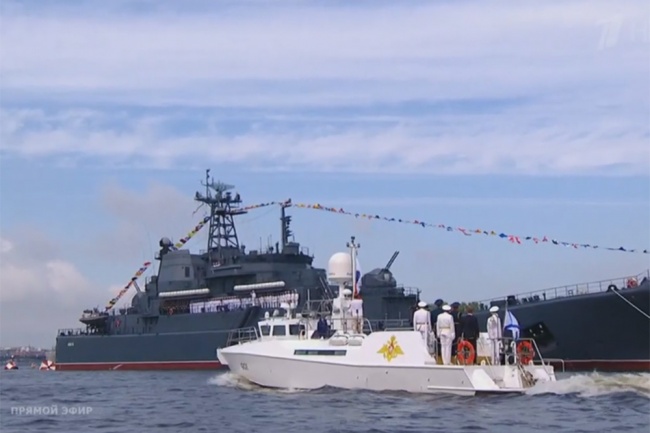
The missile boat "Dimitrovgrad" is the only guards ship formation in the Baltic Fleet. Powerful strike missile armament and maneuverability allow the boat as part of a ship group to deliver missile strikes against surface ships. "Dimitrovgrad" took part in 30 tasks of the Baltic Fleet. The ship's commander is captain of the third rank Ivan Dmitrenko.
Vladimir Putin congratulated the crew of the large anti-submarine ship Admiral Makarov. This ship served in the Atlantic, made trips to Cuba and Morocco. Refers to the project "Kronstadt".

For the first time in the history of naval parades in St. Petersburg, more than five thousand sailors of the Baltic, Northern, Black Sea fleets and the Caspian flotilla will take part in the celebrations.

Vladimir Putin's boat moored at Universitetskaya embankment.
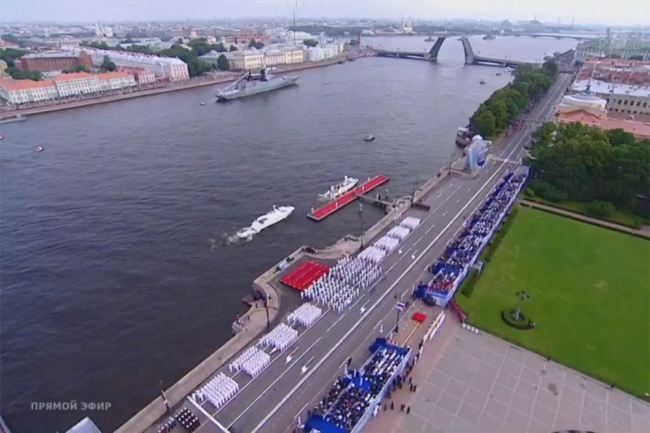
President Vladimir Putin, Defense Minister Sergei Shoigu, Commander-in-Chief of the Navy Vladimir Korolev went ashore.

The flag of the battleship "Azov" is carried along the embankment. The flag of "Azov" - the glory and pride of the Russian fleet is hoisted on the building of the Admiralty.
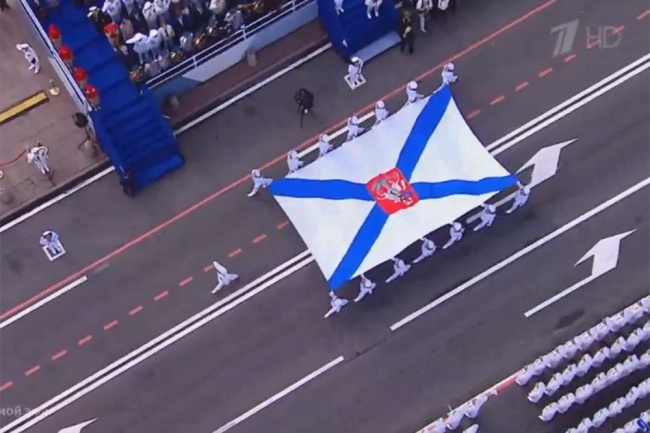
The President addressed the sailors and congratulated them on the Navy Day. "The history of Russia is inextricably linked with the victories of its fearless navy," Vladimir Putin said.
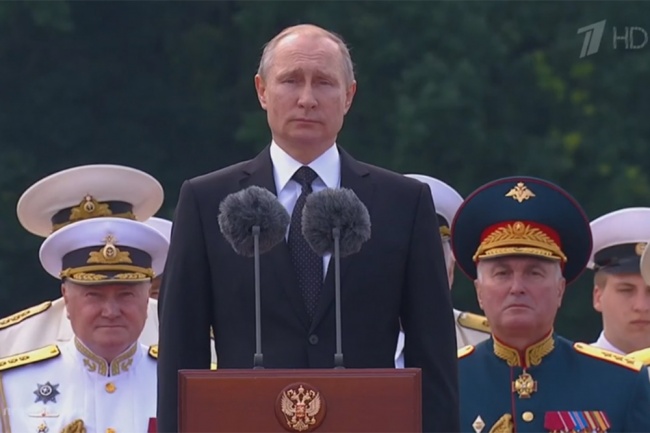
"Over the centuries, the courage and steadfastness of Russian sailors have been consolidated in battles, the traditions of maritime brotherhood have been strengthened," the president emphasized. "The fleet and devotion to the Fatherland are inseparable."
"Modern ships are coming into service, personnel training technologies are being improved," Vladimir Putin said. "Today, the navy is making a contribution to the fight against terrorism and piracy."
The anthem of Russia sounds.
On the embankment are military bands, playing a march.
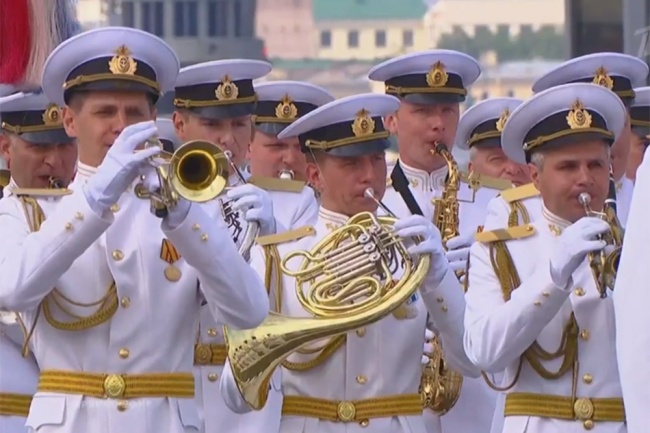
The traditions of naval parades were laid down by Peter I. In 1714, after the victory of the Russian fleet in the Battle of Cape Gangut, he held the first review of naval equipment in history.
By the way, today viewers will be able to see the small boat of Peter I, the very one from which the history of the Russian fleet began more than 300 years ago.
The naval part of the parade begins. Unlocks the passage of the parade formation of ships anti-sabotage boats.
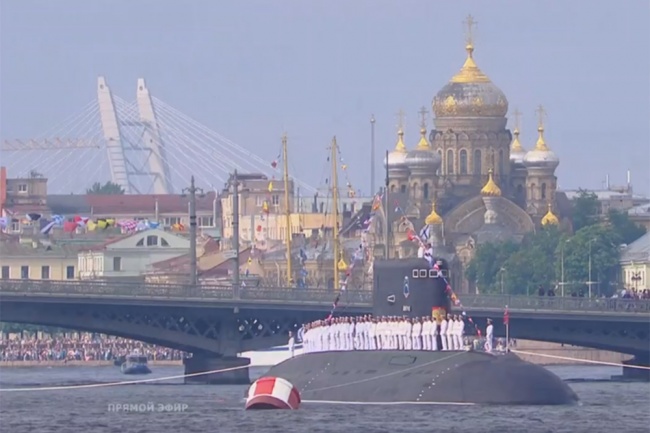
Today the boats "Yunarmeets of the Caspian Sea", "Yunarmeets of the Baltic", "Yunarmeets of Kamchatka", "Yunarmeets of the Arctic", Primorye and Crimea will pass in the parade line. Project 21980 anti-sabotage boats patrol the water area around the construction of the Kerch bridge. The group of boats is commanded by Senior Warrant Officer Alexander Kasinsky.
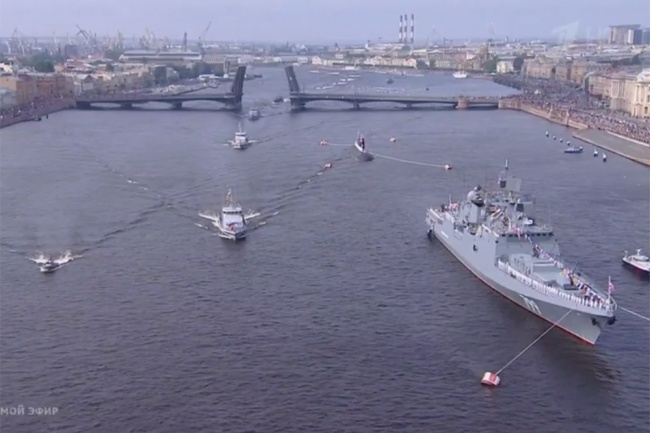
The project of anti-sabotage boats of project 21980 is known under the code "Rook". Vessels are designed to protect against threats in the waters of basing and close approaches to them and to protect state borders. The first boat of the project is called "Nakhimovets", it was commissioned in 2010.
Also in the project there are ships "Cadet", "Suvorovets", "Cadet Kirovets". Opened the maritime part of the parade
"Yunarmeets Kaspiya" was put into operation in 2013. Since then, all boats of the project have received names associated with the movement of the Yunarmiya. So the boats passed along the Neva, which received names in honor of the movements of the Baltic, Kamchatka, the Arctic, Primorye and Crimea.
![]()
Patrol boats of the Raptor series pass along the Neva. These are very small, but very maneuverable ships. Each Raptor is 16.9 meters long, 4.1 meters wide, and has a draft of 0.9 meters. The boat can reach speeds up to 50 knots or 100 kilometers per hour. The ships are capable of finding a target at a distance of up to three kilometers and firing at a distance of two kilometers.
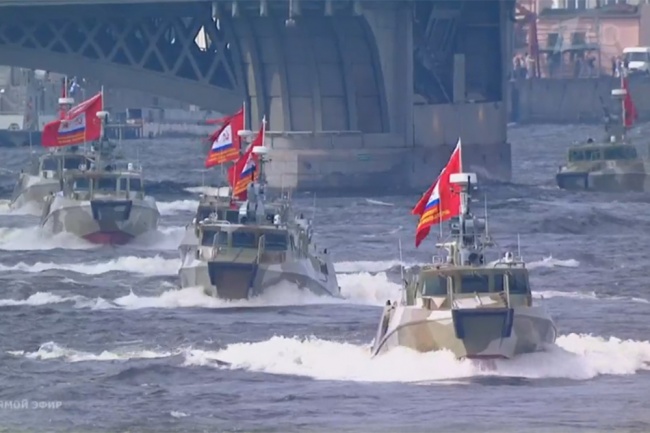
The reconstructed small boat of Peter I is being transported on the Raptor. The same boat that began the history of the Russian fleet.

The banners of famous units that took part in fierce battles during the Great Patriotic War were hoisted on the boats. Behind each banner is a story of incredible courage.
The landing craft on the air cavity completes the passage of the boats. Boats of this type are designed to solve complex combat missions due to the design features, the speed of the boat can reach 36 knots. On board the boat is a B-82 armored personnel carrier. Commander - Senior Warrant Officer Maxim Fomenko. His great-grandfather, Private Nikolai Stepanovich Tsygankov, fought and died in the battles for the city of Vyazma in March 1943.

In the ranks - raid and base minesweepers, they serve at the Leningrad naval base. The Leningrad Naval Base monitors the operational situation in the waters of the Gulf of Finland and on Lake Ladoga. Anti-mine minesweepers are capable of detecting all types of sea mines at various depths.
In 2009-2010, during the construction of the Nord Stream gas pipeline, the forces of the Baltic Fleet, including ships that are now passing along the Neva, carried out a large-scale demining of the Gulf of Finland. More than 60 explosive objects were found and neutralized. In 2011, the tasks of demining the Gulf of Ob and the coastal part of the Kara Sea were completed.
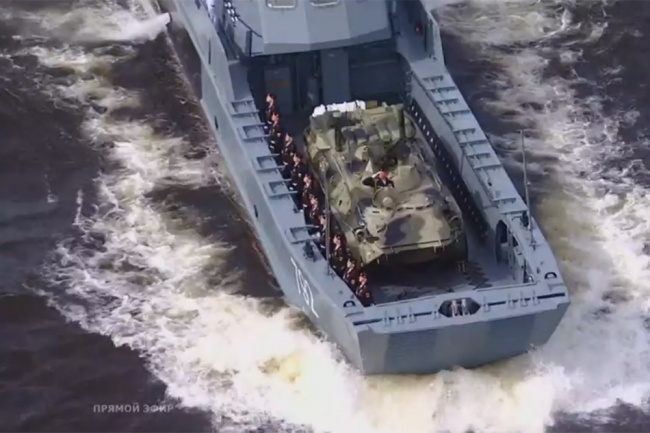
The base minesweeper of the new generation "Alexander Obukhov" is in combat formation. It was designed by Almaz Central Marine Design Bureau. The captain of the third rank Sergey Tikhonov is in command of the ship. The base minesweeper is designed to search for and destroy mines in the waters of naval bases at safe distances for the ship.
The ship is unique primarily for its hull. It is made of monolithic fiberglass, formed by vacuum infusion. The use of this technology made it possible to achieve special strength, which is important for a mine action vessel.
"Alexander Obukhov" is the lead ship of project 12700 "Alexandrite". The vessel entered the Russian Navy in December 2016. The displacement of all ships of the series is 890 tons, length - 61 meters, width - 10 meters, speed at full displacement - 16.5 knots. The ship is operated by a crew of 44 people.
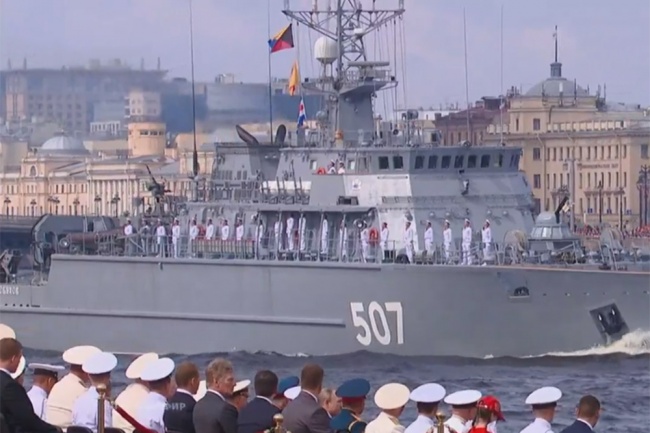
A ship's missile group enters the Neva channel. The Chuvashia missile boat of project 12411 is in charge of the parade formation. The captain of the third rank Artem Starkov is in command of the ship. Ships of the 12411 series are also known by the code "Lightning-1". These ships are designed to destroy enemy warships, as well as its transport and landing craft.
The boat "Chuvashia" was originally called "R-2", it entered the Baltic Fleet in February 2000. Since that time, the boat has completed more than 40 combat duty, more than 70 firing. The boat represented the Russian Navy in Denmark, Sweden and Finland. The ship has traveled over 15,000 miles.
The length of the boat is 56.1 meters, width - 10.2, draft - 2.5 meters, the vessel can reach speeds of up to 41 knots. In autonomous navigation, the ship can stay up to ten days. The crew of "Chuvashia" is 40 people.
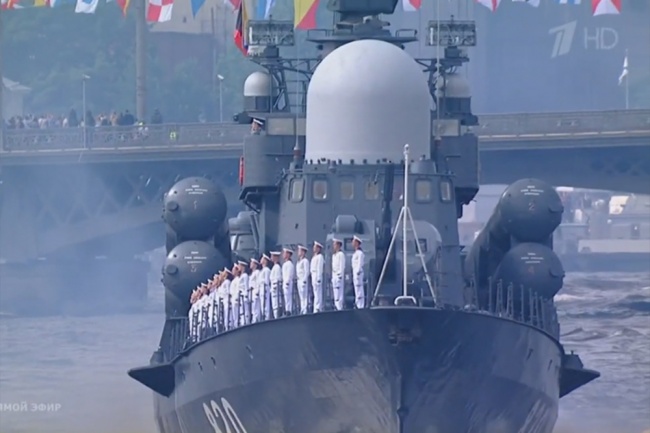
A Geyser small rocket ship under the command of third-rank captain Vladimir Kozeltsev passes along the Neva. The boat is designed to deliver missile strikes against enemy ships. The vessel itself is relatively small, its length is 59.3 meters, width - 11.8 meters, displacement - 730 tons. Despite the modest dimensions, the boat has six launchers for Moskit anti-ship missiles, anti-aircraft missile and artillery weapons.
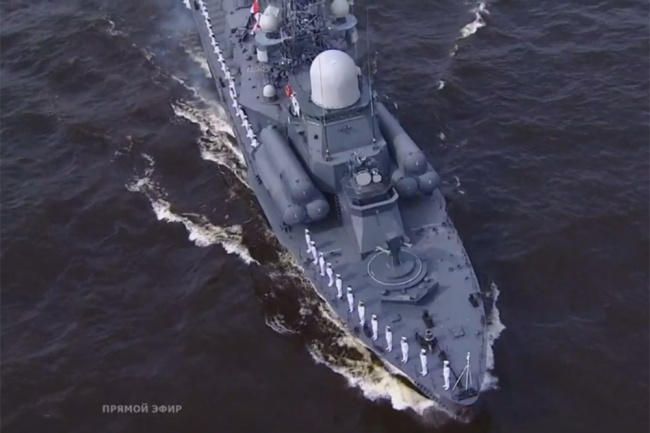
The passage of missile boats is completed by the newest small missile ship "Serpukhov", which represents a new generation of missile ships of the Navy, built by the Zelenodolsk shipbuilding plant. The captain of the ship is Lieutenant Commander Pyotr Lyushin.
The ship "Serpukhov" was enrolled in the Russian Navy quite recently, in December 2015. But already in August 2016, he was on a combat mission in Syria, which he successfully completed. "Serpukhov", like all vessels of the 21631 series, is equipped with high-precision missile weapons, which make it possible to strike both at sea and at ground targets. The ship has a gun mount capable of firing high-explosive fragmentation shells at a distance of up to 21 kilometers. Also, technical capabilities make it possible to hit air targets at an altitude of up to 15 kilometers.

Meanwhile, on the Kronstadt roadstead, an anti-submarine tactical group consisting of the small anti-submarine ships Kazanets and Zelenodolsk, as well as the large anti-submarine ship Vice-Admiral Kulakov, is in parade formation.
Ships of this class are designed to search, track and destroy submarines independently or as part of a group. They can also be used to repel enemy air and submarine forces. In 2016, the crew of the large anti-submarine ship "Vice-Admiral Kulakov" performed the task of combat service along the Northern Sea Route, and then, as part of the Northern Fleet group in the eastern Mediterranean, participated in a military operation in Syria.
"Vice-Admiral Kulakov" is a legendary ship. It joined the Northern Fleet in 1982. The length of the ship is 163 meters, width - 19 meters, draft - 7.8 meters, standard displacement - 6840 tons. The ship can stay in autonomous navigation for up to 30 days. The crew is 293 people. In 2010, after the repair, "Vice-Admiral Kulakov" returned to the Northern Fleet of the Russian Navy.
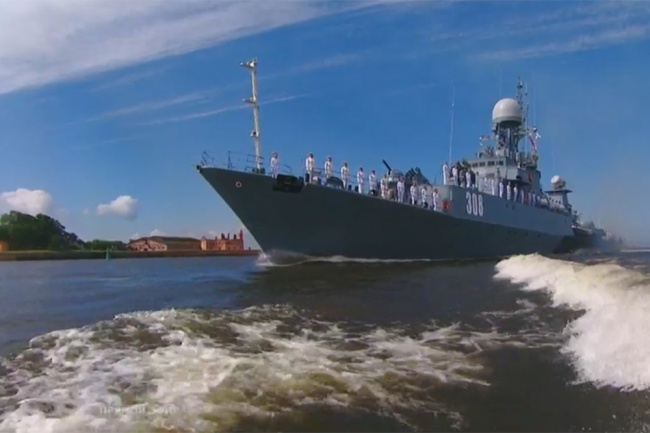
In the parade formation in Kronstadt, where their naval parade is taking place, a tactical group of the latest attack ships appeared as part of the Admiral Gorshkov frigate and the Soobrazitelny corvette.
"Admiral Gorshkov" is a large surface combat ship, the real pride of the domestic shipbuilding industry. It is equipped with the Armat universal artillery mount, and up to 16 Onyx missiles are also provided on the ship. Anti-submarine weapons are 16 anti-submarine missiles and 8 anti-submarine missiles. An aviation group is also provided in the form of one Ka-27PL helicopter.
The frigate is also unique in that up to 30 percent of completely new unique technologies and materials were used in its construction. Experts say he is virtually invulnerable. Now "Admiral Gorshkov" is finishing state tests and in November 2017 it can be transferred to the Northern Fleet.
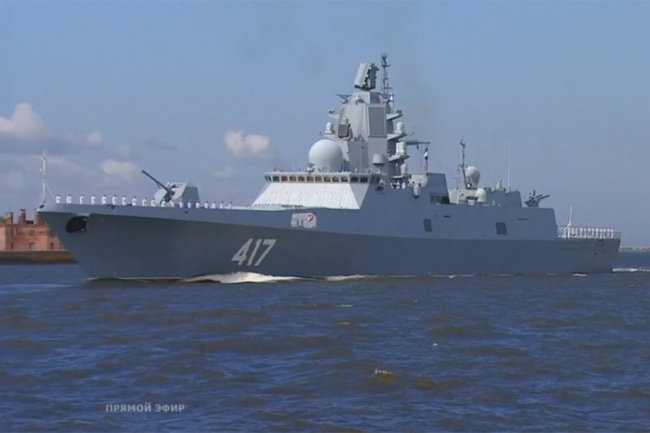
Now on the embankment of Kronstadt you can see the large landing ships "Alexander Shabalin" and "Ivan Gren". The honorable right to participate in the naval parade is entrusted to paratroopers.
The crew of the large landing ship "Alexander Shabalin" won ten times the prize of the Commander of the Navy for landing training. The captain of the third rank Alexander Shelestov is in command of the ship. "Alexander Shabalin" has been in the Navy since 1986.
The large landing ship "Ivan Gren" is the lead ship of the 11711 series. This is a new generation of Russian landing ships. "Ivan Gren" is capable of taking on board up to 380 marines and 36 units of various military equipment. The ship was launched in 2012. Sea trials of the ship are currently underway and it is planned that it will be transferred to the Navy in the fall of 2017. It is noteworthy that despite its young age, the ship has already managed to prove itself worthy: in 2016, during tests, the Ivan Gren brought a civilian boat out of a storm.

Meanwhile, a tactical group of submarines appeared on the Kronstadt embankment. It includes boats "Vladikavkaz", "Veliky Novgorod" and "Kolpino".
It is worth noting that often all these three submarines are called "Varshavyanka". But it is not so. Project 636.3 includes only Veliky Novgorod and Kolpino. And "Vladikavkaz" is a boat of project 877, which is sometimes also called "Halibut". The first "Halibuts" appeared in the early 80s, they were developed in the Rubin design bureau. From the boats of previous generations, they differed in low noise and speed. The Vladikavkaz submarine has been in the Navy since 1990.
Boats of the Varshavyanka series were originally supposed to be delivered to the Warsaw Pact countries. Work on the project was carried out in the late eighties. Then the name took shape. Initially, the Varshavyankas were built at the Krasnoye Sormovo plant, but now the submarines under project 636.3 are being built in St. Petersburg, at the Admiralty Shipyards. Veliky Novgorod and Kolpino were accepted into the Northern Fleet in November 2016. In the coming years, it is planned to build six more such submarines at the Admiralty Shipyards.

The cruiser "Marshal Ustinov" passed near the Kronstadt embankment. The captain of the first rank Sergey Alantiev is in command of the ship. "Marshal Ustinov" launched on February 25, 1982, became part of the Northern Fleet on November 5, 1986. Its length is 186 meters, width is 20.8 meters, the crew is about 500 people.
At the end of last year, a large-scale modernization was completed on the cruiser. Now the ship is armed with 16 launchers of cruise missiles, as well as complexes of anti-aircraft missile, artillery and anti-submarine weapons.
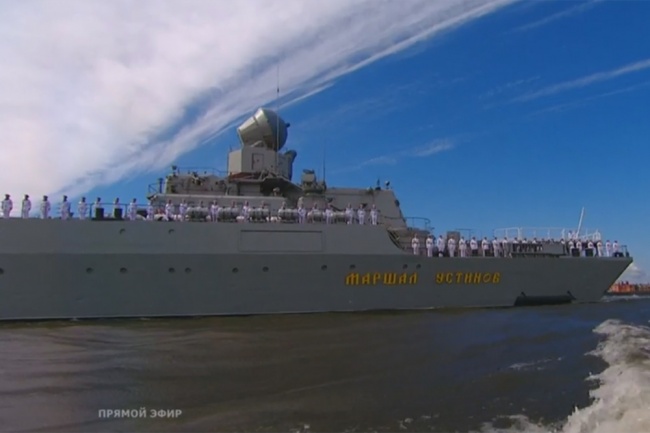
This year, guests from China also take part in the parade. The destroyer "Heifei" and the frigate "Yuncheng" pass along the Neva. Previously, these ships took part in bilateral Russian-Chinese exercises. "Yunchen" entered the fleet of the Celestial Empire in 2010. The crew made long sea voyages, visited many countries of the Pacific basin and Europe. The destroyer can reach speeds of up to 27 knots. The crew is 155 people.

The heavy nuclear submarine "Dmitry Donskoy" is moving along the Neva. This is the first ship of the 941 "Shark" series. It is equipped with the Bulava missile system with six hypersonic warheads. "Dmitry Donskoy" can dive to a depth of 320 meters and be in autonomous navigation for 120 days. This is the largest submarine in the world. The length of the vessel is 172 meters, the width of the hull is 23.3 meters. The crew of "Dmitry Donskoy" - 165 people.
On the last Sunday of July - the Day of the Navy - in St. Petersburg for the third time in history, the Main Naval Parade of the country will be held. In terms of scale, the number of participating ships and aircraft, this event will be comparable to the Victory Parade on Moscow's Red Square. The only time before that the Main Parade was held in honor of the 300th anniversary of the Navy in 1996. But the current event will surpass it in scale. This year, more than 60 ships, boats and support vessels will take part in the Main Parade. And several dozen aircraft will take to the skies (the list of military equipment is at the disposal of Izvestia). The Ministry of Defense will issue a commemorative medal especially for the participants of the Main Parade.
Previously, Navy Day was celebrated only in the main fleet bases - Astrakhan, St. Petersburg, Severomorsk, Sevastopol and Vladivostok, but on a much more modest scale and did not have the status of an all-Russian event.
RELATED MORE
As Izvestia was told at the headquarters of the Navy, the main parade will take place in the waters of St. Petersburg and Kronstadt - the historical base of the Baltic Fleet. This will be one of the largest events in the history of the Soviet and modern Russian fleet. In scope, the event will surpass the celebration of the 300th anniversary of the Russian Navy, held in St. Petersburg in 1996.
The parade will be held in the areas of Eastern Ust-Rogatka and the southern protective wall of the Middle Harbor of Kronstadt. Spectators will be accommodated there and an exhibition of samples of historical and modern military equipment of the Navy will be organized. In total, more than 60 surface ships, boats and support vessels will be involved in the holiday. To do this, they will be collected from the Baltic, Northern, Black Sea and Pacific fleets. Several dozen aircraft and helicopters of naval aviation, as well as units of the marines, coastal missile forces and engineering units will be involved. Each participant in the celebration will be marked with a medal specially established for this occasion.
The naval part of the parade will be represented by the heavy nuclear-powered missile cruiser Pyotr Veliky, the cruiser Marshal Ustinov, large landing ships Alexander Shabalin, Minsk and Kulakov. The frigate "Admiral Makarov", missile boats "Dimitrovgrad" and "Chuvashia", as well as submarines "Veliky Novgorod" and "Kolpino" will stand on the raid. Among the participants in the parade will be the Stoiky and Soobrazitelny corvettes, the Serpukhov and Geyser small missile ships, the Alexander Obukhov sea minesweeper, the BT-115 base minesweeper, and others.
For the first time in history, the world's largest strategic nuclear submarine cruiser TK-208 "Dmitry Donskoy" will take part in the parade," Captain First Rank Igor Kurdin, chairman of the St. Petersburg Club of Submariners and Navy Veterans, told Izvestia. - The ship will move to the Baltic as part of a group of warships of the Northern Fleet.
No less colorful and large-scale will be the air part of the Main Parade. On the day of its holding, all types of combat aircraft and helicopters of naval aviation will pass over the city. These are anti-submarine amphibious aircraft, or flying boat, Be-12, long-range anti-submarine aircraft Tu-142Mk and M3. Also, for the first time, the Tu-142MR will fly at the parade. This aircraft is designed to organize communication with nuclear submarines and until recently was considered top secret. Together with them, the Il-38 anti-submarine aircraft, Su-27 fighters and the latest Su-30SM, as well as Su-33 and MiG-29K carrier-based fighters that flew over from Severomorsk will be shown. Last year, these machines took part in the operation of the Russian Aerospace Forces in Syria for the first time. For the first time, the legendary "air warships" - high-altitude MiG-31 interceptor aircraft - will arrive in St. Petersburg. Attack helicopters Mi-24 and Ka-52, carrier-based Ka-29 and Ka-27, as well as military transport Mi-8 helicopters will fly over the ships of the fleet.
The tradition of holding naval parades was introduced by Peter I in 1699. The first real parade in terms of observing rituals is the parade on September 9, 1714 in honor of the victory of Russian sailors at Gangut. Parades became permanent only after the 1917 revolution. The leadership of the young Soviet Republic made the review of ships a regular event on revolutionary holidays - May 1 and November 7. Already after the war of 1941-1945, naval parades began to be organized on the day of the Navy on the last Sunday of July. At the same time, the term "Main Naval Parade" appeared only in 1996 - the year of the 300th anniversary of the creation of the Russian Navy.


